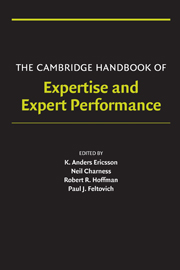Book contents
- Frontmatter
- Contents
- Acknowledgments
- Contributors
- PART I INTRODUCTION AND PERSPECTIVE
- PART II OVERVIEW OF APPROACHES TO THE STUDY OF EXPERTISE – BRIEF HISTORICAL ACCOUNTS OF THEORIES AND METHODS
- PART III METHODS FOR STUDYING THE STRUCTURE OF EXPERTISE
- PART IV METHODS FOR STUDYING THE ACQUISITION AND MAINTENANCE OF EXPERTISE
- PART V DOMAINS OF EXPERTISE
- PART VI GENERALIZABLE MECHANISMS MEDIATING EXPERTISE AND GENERAL ISSUES
- 34 A Merging Theory of Expertise and Intelligence
- 35 Tacit Knowledge, Practical Intelligence, and Expertise
- 36 Expertise and Situation Awareness
- 37 Brain Changes in the Development of Expertise: Neuroanatomical and Neurophysiological Evidence about Skill-Based Adaptations
- 38 The Influence of Experience and Deliberate Practice on the Development of Superior Expert Performance
- 39 Development and Adaptation of Expertise: The Role of Self-Regulatory Processes and Beliefs
- 40 Aging and Expertise
- 41 Social and Sociological Factors in the Development of Expertise
- 42 Modes of Expertise in Creative Thinking: Evidence from Case Studies
- Author Index
- Subject Index
- References
35 - Tacit Knowledge, Practical Intelligence, and Expertise
from PART VI - GENERALIZABLE MECHANISMS MEDIATING EXPERTISE AND GENERAL ISSUES
- Frontmatter
- Contents
- Acknowledgments
- Contributors
- PART I INTRODUCTION AND PERSPECTIVE
- PART II OVERVIEW OF APPROACHES TO THE STUDY OF EXPERTISE – BRIEF HISTORICAL ACCOUNTS OF THEORIES AND METHODS
- PART III METHODS FOR STUDYING THE STRUCTURE OF EXPERTISE
- PART IV METHODS FOR STUDYING THE ACQUISITION AND MAINTENANCE OF EXPERTISE
- PART V DOMAINS OF EXPERTISE
- PART VI GENERALIZABLE MECHANISMS MEDIATING EXPERTISE AND GENERAL ISSUES
- 34 A Merging Theory of Expertise and Intelligence
- 35 Tacit Knowledge, Practical Intelligence, and Expertise
- 36 Expertise and Situation Awareness
- 37 Brain Changes in the Development of Expertise: Neuroanatomical and Neurophysiological Evidence about Skill-Based Adaptations
- 38 The Influence of Experience and Deliberate Practice on the Development of Superior Expert Performance
- 39 Development and Adaptation of Expertise: The Role of Self-Regulatory Processes and Beliefs
- 40 Aging and Expertise
- 41 Social and Sociological Factors in the Development of Expertise
- 42 Modes of Expertise in Creative Thinking: Evidence from Case Studies
- Author Index
- Subject Index
- References
Summary
The drive to excel has long challenged humans to push their bodies, minds, and technologies in the determined pursuit of success. People have demonstrated their devotion to excellence through the years of effort and practice they have been willing to invest in accomplishing their goals (Ericsson, Krampe, & Tesch-Römer, 1993). For example, Simon and Chase (1973) observed that no one had ever attained the rank of Grandmaster in chess without at least a decade of intense preparation. This observation has since been extended to many domains, including music, sports, and academia (Bloom, 1985; Ericsson et al., 1993; Ericsson, Chapter 38). Despite folk tales about extraordinary performances by very young individuals, it is clear that the most eminent individuals in any field do not exhibit expert levels of performance prior to an extended period of preparation.
Exploration of the nature of expertise and how it develops has interested scholars, professionals, and laypeople alike, and has involved a wide range of theoretical and methodological approaches. One of the enduring debates over many years of study is whether the development of expertise is largely attributable to unusual characteristics of individuals, often thought of in terms of largely inherited talents, or of their learning histories (see Horn & Masunaga, Chapter 34).
- Type
- Chapter
- Information
- The Cambridge Handbook of Expertise and Expert Performance , pp. 613 - 632Publisher: Cambridge University PressPrint publication year: 2006
References
- 49
- Cited by



